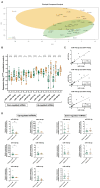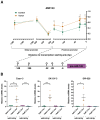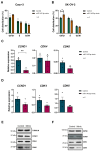Reduced Levels of miR-145-3p Drive Cell Cycle Progression in Advanced High-Grade Serous Ovarian Cancer
- PMID: 39594652
- PMCID: PMC11592657
- DOI: 10.3390/cells13221904
Reduced Levels of miR-145-3p Drive Cell Cycle Progression in Advanced High-Grade Serous Ovarian Cancer
Abstract
High-grade serous ovarian cancer (HGSOC) is the most lethal form of gynecologic cancer, with limited treatment options and a poor prognosis. Epigenetic factors, such as microRNAs (miRNAs) and DNA methylation, play pivotal roles in cancer progression, yet their specific contributions to HGSOC remain insufficiently understood. In this study, we performed comprehensive high-throughput analyses to identify dysregulated miRNAs in HGSOC and investigate their epigenetic regulation. Analysis of tissue samples from advanced-stage HGSOC patients revealed 20 differentially expressed miRNAs, 11 of which were corroborated via RT-qPCR in patient samples and cancer cell lines. Among these, miR-145-3p was consistently downregulated post-neoadjuvant therapy and was able to distinguish tumoural from control tissues. Further investigation confirmed that DNA methylation controls MIR145 expression. Functional assays showed that overexpression of miR-145-3p significantly reduced cell migration and induced G0/G1 cell cycle arrest by modulating the cyclin D1-CDK4/6 pathway. These findings suggest that miR-145-3p downregulation enhances cell proliferation and motility in HGSOC, implicating its restoration as a potential therapeutic target focused on G1/S phase regulation in the treatment of HGSOC.
Keywords: DNA methylation; cell cycle proliferation; cyclin D1-CDK4/6 pathway; high-grade serous ovarian cancer; miR-145-3p; miRNAs.
Conflict of interest statement
The authors declare no conflict of interest.
Figures




Similar articles
-
MicroRNA-625-3p improved proliferation and involved chemotherapy resistance via targeting PTEN in high grade ovarian serous carcinoma.J Ovarian Res. 2022 Jan 14;15(1):7. doi: 10.1186/s13048-021-00939-1. J Ovarian Res. 2022. PMID: 35027053 Free PMC article.
-
FOXD1 is targeted by miR-30a-5p and miR-200a-5p and suppresses the proliferation of human ovarian carcinoma cells by promoting p21 expression in a p53-independent manner.Int J Oncol. 2018 Jun;52(6):2130-2142. doi: 10.3892/ijo.2018.4359. Epub 2018 Apr 4. Int J Oncol. 2018. PMID: 29620165
-
ROR2 induces cell apoptosis via activating IRE1α/JNK/CHOP pathway in high-grade serous ovarian carcinoma in vitro and in vivo.J Transl Med. 2019 Dec 26;17(1):428. doi: 10.1186/s12967-019-02178-x. J Transl Med. 2019. PMID: 31878941 Free PMC article.
-
MiR-585-3p suppresses tumor proliferation and migration by directly targeting CAPN9 in high grade serous ovarian cancer.J Ovarian Res. 2021 Jul 8;14(1):90. doi: 10.1186/s13048-021-00841-w. J Ovarian Res. 2021. PMID: 34238324 Free PMC article.
-
miRNA-301b-3p accelerates migration and invasion of high-grade ovarian serous tumor via targeting CPEB3/EGFR axis.J Cell Biochem. 2019 Aug;120(8):12618-12627. doi: 10.1002/jcb.28528. Epub 2019 Mar 4. J Cell Biochem. 2019. PMID: 30834603
Cited by
-
Multi-Layered Analysis of TGF-β Signaling and Regulation via DNA Methylation and microRNAs in Astrocytic Tumors.Int J Mol Sci. 2025 Aug 12;26(16):7798. doi: 10.3390/ijms26167798. Int J Mol Sci. 2025. PMID: 40869118 Free PMC article.
-
Gut-Vaginal Microbiome Crosstalk in Ovarian Cancer: Implications for Early Diagnosis.Pathogens. 2025 Jun 25;14(7):635. doi: 10.3390/pathogens14070635. Pathogens. 2025. PMID: 40732683 Free PMC article. Review.
-
Unraveling the Role of the microRNA-Mediated Regulation of Actin-Binding Proteins in Ovarian Cancer: A Narrative Review.Cancers (Basel). 2025 Jul 11;17(14):2315. doi: 10.3390/cancers17142315. Cancers (Basel). 2025. PMID: 40723199 Free PMC article. Review.
-
Hsa-miR-21-5p and Hsa-miR-145-5p Expression: From Normal Tissue to Malignant Changes-Context-Dependent Correlation with Estrogen- and Hypoxia-Vascularization-Related Pathways Genes: A Pilot Study.Int J Mol Sci. 2025 May 7;26(9):4461. doi: 10.3390/ijms26094461. Int J Mol Sci. 2025. PMID: 40362695 Free PMC article.
References
-
- The International Agency for Research on Cancer (IARC) Global Cancer Observatory. [(accessed on 7 July 2022)]. Available online: https://gco.iarc.fr.
-
- Marí-Alexandre J., Carcelén A.P., Agababyan C., Moreno-Manuel A., García-Oms J., Calabuig-Fariñas S., Gilabert-Estellés J. Interplay Between MicroRNAs and Oxidative Stress in Ovarian Conditions with a Focus on Ovarian Cancer and Endometriosis. Int. J. Mol. Sci. 2019;20:5322. doi: 10.3390/ijms20215322. - DOI - PMC - PubMed
-
- Ledermann J.A., Raja F.A., Fotopoulou C., Gonzalez-Martin A., Colombo N., Sessa C. Newly diagnosed and relapsed epithelial ovarian carcinoma: ESMO Clinical Practice Guidelines for diagnosis, treatment and follow-up. Ann. Oncol. 2013;24((Suppl. S6)):vi24–vi32. doi: 10.1093/annonc/mdt333. - DOI - PubMed
Publication types
MeSH terms
Substances
Associated data
- Actions
Grants and funding
- PI17/01945/Instituto de Salud Carlos III
- PI22/01872/Instituto de Salud Carlos III
- GV/2020/200/Generalitat Valenciana
- Prize SOGCV 2019/"Sociedad de Obstetricia y Ginecología de la Comunidad Valenciana" (SOGCV)
- Prize FIHGUV 2019/Fundacio Investigacio Hospital General Universitari De Valencia
- ACIF/2020/216/Generalitat Valenciana
- Pre-doctoral grant 2023 Valencia/Asociación Española Contra el Cáncer
- Pre-doctoral grant 2022 Valencia/Asociación Española Contra el Cáncer
- CNS2022-135933/Ministerio de Ciencia, Innovación y Universidades
- PID2020-114459RA-I00/Ministerio de Ciencia, Innovación y Universidades
- PLEC2022-009246/Ministerio de Ciencia, Innovación y Universidades
- Grant/Fundación Ramón Areces
- Grant/Amunt Contra el Càncer
LinkOut - more resources
Full Text Sources
Medical
Molecular Biology Databases
Research Materials

